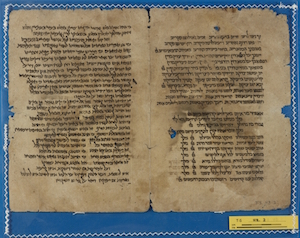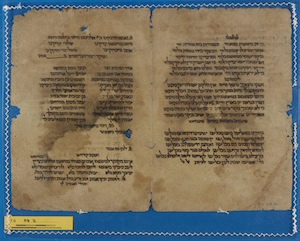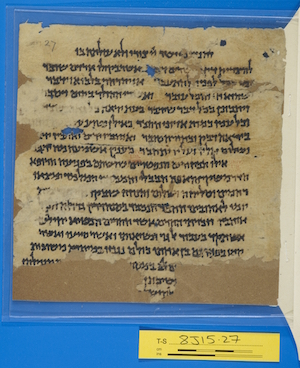Eli ben Yehoshua al-Lāḏiqī: a newly identified copyist of liturgical manuscripts
By Michael Rand
A serious problem facing Genizah scholars conducting paleographical research on manuscripts in which non-documentary (i.e., literary or liturgical) texts are copied is the lack of information pertaining to the identity of the copyist and the time/place of the writing. This obstacle to research has its roots in at least two distinct circumstances. First, many of the manuscripts in question give the impression of having been produced for various informal uses, and therefore probably lacked such information even in their pristine state. Second, in more formal manuscripts that may, in their original condition, have included a colophon indicating the desired information, the process of fragmentation and dispersal that affected so many of the Genizah materials must have led to the physical disassociation of the leaf containing the colophon from the rest of the manuscript fragments stemming from a particular codex. This problem is all the more to be expected as a colophon would typically appear at the end of a codex—i.e., on its last leaf (or one relatively close to the outside), which is much more likely to become detached from the rest of the codex than a leaf closer to its core as a simple consequence of the regular use of the book. In this way, we may even surmise that some of the codices whose remains we find in the Genizah may have lost their colophons already at the time of their having been deposited there.
In view of this problem, while it may, in principle, be possible to gather together all of the materials copied by a single hand—provided that that hand is sufficiently distinctive to allow the analyst to pick it out of the sea of Genizah fragments—it is impossible to localise the materials thus identified within a specific time and place. In the case of liturgical Genizah manuscripts, this limitation impedes research into the development of Jewish liturgy in the medieval East, as we are limited in our ability to study its diachronic development on the basis of the comparison of identifiable, localised rites. The practical outcome of this state of affairs is that research in this field has tended to proceed by tracing the evolution of discrete liturgical texts, both statutory as well as poetic, rather than the evolution of the organic liturgical rites within which they were embedded. As a result, we observe a certain (unavoidable) distortion of the manuscript data, for what was deposited into the Genizah were texts attesting to various eastern liturgical rites, while what scholars have tended to reconstruct and edit are discrete liturgical texts.
There are, to be sure, exceptions to this general state of affairs. These, however, only prove the rule. Thus, Fleischer identified and studied liturgical materials copied by Yedutun ha-Levi.[1] We might also cite the well-known and prolific copyist of piyyuṭ Eli ben Yehezqel ha-Kohen,[2] as well as Paltiel ben Ephraim.[3] As stated above, from a practical point of view, the identification and collection of fragments written in a given hand among the vast plethora Genizah materials requires that the hand be sufficiently distinctive as to be easily identifiable. This condition is easily satisfied in the case of the above-mentioned copyists. In the case of these three, various circumstances have allowed researchers to identify a certain hand with a person known from the documentary sources. In addition to such cases, where a hand can be “named” and localized in time and space, there are other groups of manuscripts preserved in the Genizah which are clearly copied by the same scribe, who remains anonymous. Perhaps the best-well known such group is the one produced by a very prolific scribe whose hand may be seen in T-S NS 232.11. In the case of another such group, a chance discovery has made it possible to identify the scribe.
Scholars have long recognised the presence in the Genizah of a unique hand, in which many manuscripts of piyyuṭ have been copied. This hand is attested in two basic varieties, one more formal and one more cursive—see for example T-S H8.2 below, a non-continuous bifolium in which the text in fol. 1b is copied in the formal style, while that in fol. 2a appears in the cursive variety. The piyyuṭim copied in this hand cover a wide chronological range, from the Classical to the Late Eastern phases of piyyuṭ and beyond, and were composed by many different payṭanim. Among them, we find piyyuṭ compositions containing the following three names in the acrostic signatures: עלי, דוסא (sometimes found together in a single acrostic: דוסא עלי) and יהושע (variants: יהושע אללאדקי, יהושע חזן, יהושע החזן , יהושע חבר). In one case, a familial relationship is indicated: דושׂא החזן בן יהושע. The frequency and clustering of these names led Fleischer to surmise that they represent members of a single group or family, one of whom is also our copyist.[4] He also mentioned in passing that a family whose members bear the names in question is attested in the documentary Genizah. In his first treatment of the subject (see note 4), Fleischer furthermore identified יהושע אלאדקי (i.e., אללאדקי, from Latakia in Syria) from our liturgical manuscripts with יהושע אלחזאן בן אלאדקי, who is known to have had a poetic exchange with a certain עלון בן אברהם, resident in Syria around the year 1015. On the basis of this identification, he suggested that the individuals bearing the names that appear in our liturgical fragments are to be located in Syria-Palestine at around the end of the 10th or the beginning of the 11th centuries.
Cambridge University Library T-S H8.2: an example of a liturgical manuscript copied by members of the Lāḏiqī family
Among the piyyuṭim copied by the hand that produced the manuscript fragments that we are investigating, we find a qedushta for one of the three Sabbaths of Rebuke, Shabbat Shim‘u. This qedushta closes with the silluq תשמיע ניחומים ללישה by the Classical payṭan Yoḥanan ha-Kohen, copied in ENA 3443/2 in the cursive style.[5] Additional copies of the silluq are found in the Genizah, but most important for our purposes is a manuscript in which it is merely mentioned by incipit: Frankfurt 152 (Schocken Institute photograph). In this source, which was likely produced by a ḥazzan for his private use, we find piyyuṭim constituting a liturgical program for Shabbat Shim‘u. The last of these, our silluq, is mentioned in a Judaeo-Arabic note: סלוק. תשמיע ניחומים ללישה. והו מצחח פי נסכה עלי בן יהושע החבר ‘ Silluq: תשמיע ניחומים ללישה. It[s text] is properly established in the version of Eli ben Yehoshua he-Ḥaver’. The names mentioned here agree with the names attested in the acrostic signatures found in our manuscripts. Furthermore, the note in ms. Frankfurt indicates that Eli ben Yehoshua he-Ḥaver had produced a manuscript containing piyyuṭim, of unknown extent, the silluq תשמיע ניחומים ללישה among them. This also tallies with the suggestion already made by Fleischer that Dosa, Eli and/or Yehoshua are connected to the production of the manuscript material that contains the piyyuṭim bearing their names.
Taking the evidence of the acrostic signatures in our manuscripts together with that of the note in ms. Frankfurt, we may reconstruct the following picture. The hand that copied ms. ENA 3443/2 along with all the other leaves bearing the same handwriting is that of Eli ben Yehoshua he-Ḥaver. This is presumably the same Eli whose name appears in the acrostic signatures of numerous piyyuṭim that are copied in these materials. The father of Eli was Yehoshua he-Ḥaver, whose name is also attested in the acrostic signatures of poems copied therein. Before becoming a ḥaver (i.e., an official member of the Palestinian rabbinic establishment), this Yehoshua, whose family was originally from Latakia, had been a ḥazzan. As we have seen, the acrostics in question also explicitly indicate the existence of a familial relationship between two of the three names: דושׂא החזן בן יהושע. According to this signature, Dosa was also a ḥazzan, as his father had been. We have also seen that in some cases, Dosa appears together with Eli in the same acrostic: דוסא עלי. Taken together, these data seem to indicate that the two were brothers.
Documentary materials can confirm this reconstruction with a reasonable degree of certainty. The most important of these is T-S 13J23.5, a letter written around the middle of the 11th century to Dosa ben Yehoshua he-Ḥaver al-Lāḏiqī in Fusṭāṭ by his mother in Raqqa in Syria.[6] In another letter, T-S 24.59, also apparently written in the middle of the 11th century, we read of Eli ben Yehoshua, presumably the brother of Dosa, a permanent ḥazzan and communal official in Raqqa; see l. 26:[7] קבעוה והו חזאן פי אלרקה מקדם אלבלד. From this source we learn that Eli, like Dosa and their father Yehoshua before them, was a ḥazzan. Such a profession obviously tallies with his activities as a copyist of liturgical material.
The evidence that we have surveyed here indicates that the materials in question were produced around the middle of the 11th century by Eli ben Yehoshua. This Eli was settled in Raqqa, whereas his brother Dosa was resident in Fusṭāṭ. The brothers belonged to the al-Lāḏiqī family. The presence in Fusṭāṭ of the liturgical materials copied by Eli is presumably to be explained on the basis of his family connection to Dosa. Finally, in addition to liturgical materials, Eli is known to have produced an epistle to an individual whose name does not survive, but who is addressed as החבר הנכבד בסנהדרין גדולה ‘the honorable ḥaver of the Great Sanhedrin’, i.e., a member of the Palestinian academy—see T-S 8J15.27 below. This document, along with the fact that the liturgical materials copied by Eli show clear signs of representing the Palestinian liturgical rite, confirm the conclusion arrived at from other sources that Dosa and Eli, like their father before them, belonged to the Palestinian establishment.[8]
In the future, I intend to produce a full study of the liturgical materials copied by Eli ben Yehoshua.
Cambridge University Library T-S 8J15.27: a letter by Eli ben Yehoshua to a member of the Palestinian academy
Footnotes:
[1] Fusṭāṭ, first quarter of the 13th century. For references and a sample of his writing see my “Additional Fragments Belonging to the First Order of Fustat,” Fragment of the Month, November 2011.
[2] Jerusalem, mid-11th century; see Beeri 2007, p. 174. For a sample see T-S H3.104.
[3] Fusṭāṭ, beginning of the 11th century; see Bareket 1999, pp. 187-188. The document mentioned in note 296 without a shelf-mark is T-S 24.11, and Paltiel copied the entire document, rather than merely being one of its signatories, as Bareket writes. See also Loeffler 2002, pp. 156-157. For a sample see T-S NS 148.40.
[4] See Fleischer 1984, pp. 454-456 and idem 2001, pp. 13-14.
[5] I intend to publish a new edition of this silluq in a forthcoming article: ‘New Data on Aramaic in Classical piyyuṭ – תשמיע ניחומים ללישה, a Silluq for Shabbat Shim‘u by Yoḥanan ha-Kohen’.
[6] See Gil 1997, vol. 2, pp. 236-240.
[7] See Gil 1983, vol. 2, pp. 356-359.
[8] See Gil 1997, vol. 1, pp. 512-513.
Bibliography
Bareket, E. Fustat on the Nile – The Jewish Elite in Medieval Egypt (Leiden-Boston-Köln, 1999).
Beeri, T. שניים שהם שלושה: לבירור זהותם של כמה פייטנים מזרחיים מן המאה האחת עשרה, Jerusalem Studies in Hebrew Literature 21 (2007), pp. 171-182.
Fleischer, E. היוצרות בהתהוותם והתפתחותם (Jerusalem, 1984).
Fleischer, E. '(!) חדותה ', Italia 13-15 (2001), pp. 9-30.
Gil, M. ארץ-ישראל בתקופה המוסלמית הראשונה (1099-634) (Tel Aviv, 1983).
Gil, M. במלכות ישמעאל בתקופת הגאונים (Tel Aviv/Jerusalem, 1997).
Loeffler, B. '"ונוסף עוד" – נוספות על נוספות למחזור יניי' Asupot 14 (2002), pp. 155-213.
Cite this article
(2014). Eli ben Yehoshua al-Lāḏiqī: a newly identified copyist of liturgical manuscripts. [Genizah Research Unit, Fragment of the Month, November 2014]. https://doi.org/10.17863/CAM.8239
Contact us: genizah@lib.cam.ac.uk
The zoomable images are produced using Cloud Zoom, a jQueryimage zoom plugin:
Cloud Zoom, Copyright (c) 2010, R Cecco, www.professorcloud.com
Licensed under the MIT License



